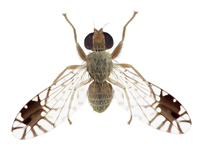Abstract
The semi-fossorial snakes of the genus Atractus Wagler 1828 are widely distributed throughout South America, ranging from Panama to northeastern Argentina at elevations from sea level to 4500 m (Passos et al. 2013a). Atractus currently comprises 150 species that inhabiting several types of tropical habitats, being the most diverse genus of snakes in the world (Passos et al. 2018). Colombia harbours the most species richness of the genus with about 42 currently recognized species, representing about 1/3 of generic diversity (Uetz et al. 2018). Köhler & Kieckbusch (2014) recently has named Atractus alytogrammus based on an individual collected by Federico Meden more than fifty years ago near the municipality of San José de Guaviare (2°33’55’’N, 72°38’19’’W). The second known specimen of A. alytogrammus was found by A.F. Aponte (male, ICN-R-13018) hidden under a pile of palm leaves (3°00’05"N, 72°13’9.9"W; 209 m above sea level) at 7:58 am on February 02 2016 in the oil palm plantations of POLIGROW Colombia Ltda, municipality of Mapiripán, department of Meta, Colombia. This region is located in the Orinoquia-Amazonia ecotone 82 Km (airline) northeast from the type-locality (Fig. 1). I report herein the unknown color in life (Fig. 2), change of shades after preservation (Fig. 3B–D) and hemipenial morphology (Fig. 4), besides amplifying the meristic and morphometric variability of this poorly known species (Table 1).
References
Köhler, G. & Kieckbusch, M. (2014) Two new species of Atractus from Colombia (Reptilia, Squamata, Dipsadidae). Zootaxa, 3872 (3), 291–300.
https://doi.org/10.11646/zootaxa.3872.3.5
Passos, P., Kok, O.J., Albuquerque, N.R. & Rivas, G.A. (2013a) Groundsnakes of the Lost World: a review of Atractus (Serpentes: Dipsadidae) from the Pantepui region, northern South America. Herpetological Monographs, 27, 52–86.
https://doi.org/10.1655/herpmonographs-d-12-00001r2.1
Passos, P., Ramos, L.O., Pinna, P.H. & Prudente, A.L. (2013b) Morphological variation and affinities of the poorly known snake Atractus caxiuana (Serpentes: Dipsadidae). Zootaxa, 3745 (1), 35–48.
http://dx.doi.org/10.11646/zootaxa.3745.1.3Passos, P., Prudente, A.L.C., Ramos, L.O., Caicedo-Portilla, J.R. & Lynch, J.D. (2018) Species delimitations in the Atractus collaris complex (Serpentes: Dipsadidae). Zootaxa, 4392 (3), 491–520.
https://doi.org/10.11646/zootaxa.4392.3.4
Prudente, A.L.C. & Passos, P. (2010) New cryptic species of Atractus (Serpentes: Dipsadidae) from Brazilian Amazonia. Copeia, 2010, 397–404.
https://doi.org/10.1643/ch-08-193
Uetz, P., Freed, P. & Hošek, J. (2018) The Reptile Database: reptile checklist 2018. Available from: http://www.reptile-database.org/data/Reptile_checklist_2018_02.xlsx (accessed 19 August 2017)

